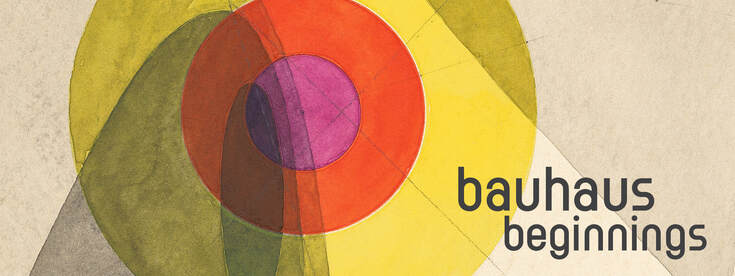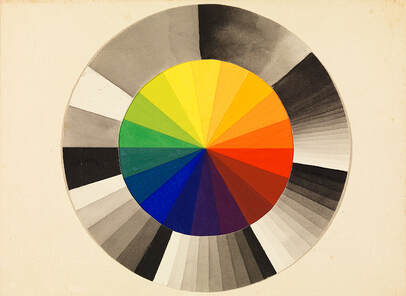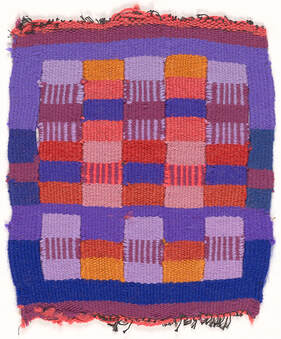'Bauhaus Beginnings' Celebrates Anniversary of One of the Most Influential Schools of Art & Design9/13/2019  'Form and color study' Joost Schmidt, ca. 1929–1930. The Getty Research Institute, 'Form and color study' Joost Schmidt, ca. 1929–1930. The Getty Research Institute, The Getty’s exhibition Bauhaus Beginnings celebrates the school of Bauhaus’ 100-year anniversary. It’s superb. It presents over 250 artifacts from Getty’s Research Institute collection using a variety of medium including video and digital images. There’s much to unpack, which is why I went a second time and joined a public tour led by one of the co-curators. I learned more about the roots of the school, the significant impact the Bauhaus had not only in Germany but internationally, the innovative curriculum, the ‘masters’ (teachers), and the students including the female students who were forced to pursue ‘feminine’ courses of study. But the Bauhaus was short-lived; its doors closed in 1933, only fourteen years after opening in 1919 due to pressure from the Nazis. Yet despite its brief stint, Bauhaus’ influence on art, architecture and design were (and still are) significant. I share here the exhibition highlights, images and a video clip featured, along with a handful of sites and media for those wanting to dig deeper. History of Bauhaus Staatliches Bauhaus, known simply as ‘Bauhaus’ (literal translation is ‘building house’ but was understood as ‘school of building’) was founded in Germany by Walter Gropius. Gropius’ (idealistic) vision was to create a school that bridged art and craftsmanship, incorporated spiritual ideals, and overcame the divide between academia and workshop trades. Gropius wanted to create a new, modern and better society using the multi-disciplinary approach of the Bauhaus. Though forward looking, Gropius also looked backwards to medieval times when guilds worked collectively to build and create. Architects, sculptors, painters—we all must return to craftsmanship! For there is no such thing as “art by profession”. There is no essential difference between the artist and the artisan…So let us therefore create a new guild of craftsmen, free of the divisive class pretensions that endeavoured to raise a prideful barrier between craftsmen and artists! --Bauhaus Manifesto, 1919  Color wheel and tone study for Paul Klee's Course, Hilde Reindl, ca. 1927. The Getty Research Institute Color wheel and tone study for Paul Klee's Course, Hilde Reindl, ca. 1927. The Getty Research Institute The Exhibition The exhibition, located in the Getty’s Research Institute building, is divided into three distinct spaces. Yet before entering the exhibition there’s a good overview of the Bauhaus using text and images—this give context. I always appreciate this approach by museums. It’s like an on-boarding to prepare visitors for the exhibit (image below). Once in the exhibition, the first space introduces the philosophy and spiritual aspect of the school, the second focuses on the preliminary courses that all students took in the first year. Artifacts here include teaching tools used by teaching ‘masters’ from artists that include well-known names such as Vassily Kandinsky, illustrations from courses, notebooks of students and media illustrating instructional concepts. The third exhibition space includes artifacts and media from the ‘workshops’—the course of study students enrolled in after the first year of preliminary coursework. There’s several gorgeous works here, including samples of textiles from Bauhaus’ weaving workshop and images from the architecture, stage and print workshops. Highlights of First Exhibition Space: Introduction The artifacts and exhibition labels in this space highlight the deep-rooted spirituality themes present at the school; though beliefs were diverse as many of the teachers hired by Gropius had diverging and sometimes strident set of values that influenced students and the curriculum. Exhibit labels describe Swiss painter Johannes Itten, who followed a branch of neo-Zoroastrian religion, Kandinskey who was a committed transcendentalist, and Adolf Meyer a theosophist. Reinforcing the spiritual theme are the impressive selection of Bauhaus woodcuts from the first publication created in Bauhaus’ print workshop titled Zwölf Holzschnitte (Twelve Woodcuts). According to the co-curator the woodcut technique was reminiscent of print making technique from the Medieval period when print craftsmen worked in guilds. An image of cathedral using the Woodcut technique was featured in the Bauhaus manifesto, which Gropius included as it referenced the pre-industrial art form. Highlights of Second Space: The First Year The next exhibit space (the largest) is dedicated to media and artifacts related to the first year of classes at the Bauhaus. The ‘preliminary courses’, which all students had to complete before moving into a specific ‘workshop’, focused on the fundamental of art and design including material studies, figure and analytical drawing and colour study. The fundamentals may seem basic on the surface but Gropius and the master teachers agreed on a curriculum that built on the core elements, with ‘building’ at its core (image below). The first year courses were taught by true masters, artists that are studied and admired today—Paul Klee, Vassily Kandinsky, Johannes Itten and others. The exhibits are marvelous, showing tools that aimed to teach students about interactions of colours, influenced by shapes and juxtapositions. The student notebooks are incredibly detailed, beautiful--works of art (image below).  Weaving sample for wall hanging, Immeke Mitscherlich-Schwollmann, ca. 1925. The Getty Research Institute. Weaving sample for wall hanging, Immeke Mitscherlich-Schwollmann, ca. 1925. The Getty Research Institute. Highlights of Third Space: Weaving, Architecture and the 1923 Exhibition The third space is dedicated to productions from the school's workshops and print materials promoting an exhibition the school held in 1923. The majority of works are from the school’s latter years, by then under a different director when the philosophy had also shifted in response to the pressure from the government due to the political leanings of some of its faculty. One outcome was the 1923 exhibition, which aimed to showcase its products that demonstrated the school's commitment to technology, with a new guiding principle of ’art and technology’ where workshops were embracing mass production; it wanted to highlight its productivity and practicality. A large glass case showcases the promotional postcards from the 1923 exhibition (image above). They’re charming. Several are available as postcards in the gift shop. Also in this space are several weaving and carpet design studies from the textile workshop, drawings and sketches from the architecture workshop (added in 1927) and furniture design workshops. Women at the Bauhaus The textile workshop was the most commercially successful for the Bauhaus, yet it was dominated by women. A touchy area in the history of the school given that even though half of students admitted to Bauhaus were women (more so in early years) almost all were forced into the weaving workshop. Only a handful were able to follow other paths. One woman, Alma Siedhoff-Buscher, entered into the wood-sculpture workshop because she claimed she wanted to design children’s furniture. The co-curator of our tour did a good job emphasizing the complexity of the weaving process, aimed to alleviate the grumblings among our tour participants. Women at the Bauhaus is an interesting study—the school was viewed as progressive in its championing of gender equality, yet the ratio of women faculty to men was not representative of the student body and women artists studying at the Bauhaus were not recognized as were their male counterparts. The ‘Stage Workshop’ A section of the exhibit space is devoted to ’stage’ featuring lithographs, a woodcut, and prints from Bauhaus’ stage workshop. Theatre productions at the Bauhaus were large-scale, known for their complicated and involved performances that incorporated design, art, mechanization that built on the foundational concepts taught in first year. The exhibit features a video of a re-creation of a stage production from 1923, titled ‘Das mechanische Ballett (The mechanical ballet)’. The same video (below) on YouTube was restaged by Theater der Klänge in 2009. It’s roughly five minutes; if you’re in a time crunch skip to minute 3.00 where it gets more interesting Final Thoughts Bauhaus Beginnings runs through to October 13, 2019. It provides an excellent snapshot into Bauhaus’ founding principles and its influence on art, design and architecture. If you aren’t able to visit in person there are several excellent sites to view Bauhaus artworks, initiatives, and to learn more about the Bauhaus philosophy, teaching methods, artists and ongoing influence. I’ll be publishing another post in two weeks about three very good online exhibitions about the Bauhaus. There’s also no shortage of interesting books, sites and resources for those interested in digging deeper into this unique and influential school. References and Resources
0 Comments
Your comment will be posted after it is approved.
Leave a Reply. |
Museums for Real is a blog with insights and ideas on how to make museums relevant and enjoyable for everyone.
|